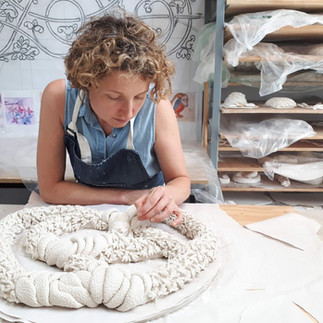METAcéramique
- centredartrozynski
- Jul 1, 2021
- 4 min read
Updated: Aug 8, 2024
It is from August 2021 that we are pleased to welcome the META group at the Rozynski Art Centre as part of a one-year residency supported by the Conseil des arts et des lettres du Québec.
Through their long-term residency at centre, the research group made up of five artists will conduct research with the central interest of advancing and laying out the various issues of the ceramic medium, or clay medium more broadly.

The group describes its approach as follows:
"Our research group was formed in 2019 and began to lay out certain research trajectories that fall within the artistic and theoretical interests of its member-artists, who are Judith Dubord (Saint-Jean-Port-Joli, Chaudière-Appalaches ), Yanik Potvin (Hébertville, Saguenay-Lac-Saint-Jean), Amélie Proulx (Lévis, Chaudière-Appalaches), Marianne Chénard (Sainte-Luce, Bas-Saint-Laurent) and Loriane Thibodeau (Montreal). It is essential for the five of us to ensure that the interests of each can serve META , and that META can serve the personal practice of its founding members. It is also important for the relevance of such a group that the individual artistic practices of its members are heterogeneous. In this sense, the research hypotheses can arise from different horizons, but the central interest of META is the advancement and unfurling of the various problematics of the ceramic medium or the clay medium more broadly. It is important to consider that the founding members are above all artists in their own right and that their motivations echo their personal work in advancing their approach."
Research Objectives
The group considers that the center's archives, its geolocation, its relationship to the community or its historicity could allow it to clear several research hypotheses and archive several artistic proposals produced during the residency. It separates its fields of interest into two meta-categories of potential research:
The first, fundamental research , looks at everything surrounding the relationship to matter in the physico-chemical sphere. According to META , “[the results of this research] could be useful for form/surface relationships, firings, the development of new ceramic materials, architecture and monumental sculpture, the prospecting of local clay, etc. ".
The second, contextual research , refers to the socio-cultural aspects of working with clay. In this research, the group is particularly interested in archival research around phenomenology:
“The phenomenological approach to research-creation confers several advantages, starting with the abandonment of our preconceptions. In this perspective, the members will have to leave behind their acquired knowledge concerning the realization, the production or the setting in space of the work of the clay. It would therefore be appropriate to experience clay/ceramics as a phenomenon meeting our subjectivity. Subjectivity pruned as much as possible from conventions or habits rooted in our personal practice. This approach would reflect real field work; a period of exploration of possibilities, accumulation of materials, various experiments, archiving and dissemination. »
In addition to the above objectives, there is a third research objective, the encounter with the milieu, the local community of the Rozynski Art Center.
Members
Judith Dubord
Ceramist, glassmaker, and member of META , Judith Dubord has a practice oriented towards the design and production of craft objects where the mixing of materials takes an important place.
Clay is his favorite medium because of the historical significance it attributes to it, but also because of all the possibilities of physico-chemical transformations it offers.
Through its formal approach, she searches for contrasts and dichotomies between shapes, colors and patterns. She tirelessly explores the fine line between delicateness and disarray.
Yanik Potvin
Interested in anthropology as much as he is in aesthetics, Yanik Potvin uses the ceramic medium, its community, its history, or its recurrences in the field of art as a prism for research, allowing him to operate theoretical shifts in other areas of knowledge.
His current approach aims to be the conjunction of a transgressive thought and an already structural thought. He lives in doubt that art and its institutions can be an asylum for social marginality.
Amélie Proulx
Porcelain, this material considered immutable over time, is the foundation of the research of Amélie Proulx , multidisciplinary artist and member of META .
Her creations begin with the premise that before firing, clay is flexible and can be
indefinitely transformed if it remains moist. Her explorations with the material lead her to develop various strategies to thwart the inherent characteristics of ceramics and suggest that it can remain flexible and in perpetual transformation.
Marianne Chénard
Les œuvres de Marianne Chénard révèlent une sensibilité quant à la perception de l'histoire, des lieux, de la mémoire et des absences, et sont grandement influencées par une exploration de la nature. Son travail a été présenté dans diverses expositions solos et collectives au Québec, au Canada et en France.
Formée en beaux-arts et poursuivant présentement sa maîtrise à Alfred University dans l’état de New York, elle propose notamment des formations spécialisées en techniques de transfert d'images sur argile.
The works of Marianne Chénard reveal a sensitivity to the perception of history, places, memory and absences, and are greatly influenced by an exploration of nature. Her work has been presented in various solo and group exhibitions in Quebec, Canada and France.
Trained in fine arts and currently pursuing her master's degree at Alfred University in New York State, she teaches clay image transfer techniques, among others.
Loriane Thibodeau
Montreal artist Loriane Thibodeau situates her work in a universe imbued with fantasy and chaos. Member of META, she holds a DEC in Fine Arts and is currently pursuing a BFA at Concordia University.
Involved with various ceramic research groups, she deals with disasters in the broad sense. Loriane Thibodeau thus explores the banal and the breaking point. Her sculptures use enigma and satire to deal with everyday life and its pivotal moments. A warm thank you to the CALQ, whose support rendered this residency possible.

















































